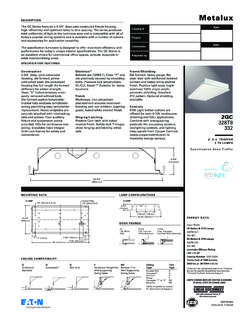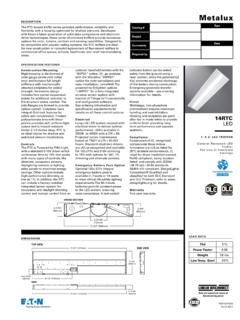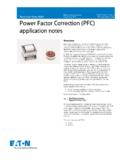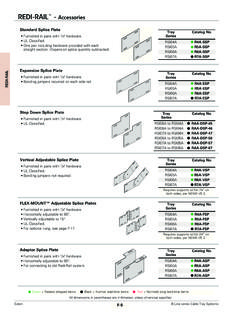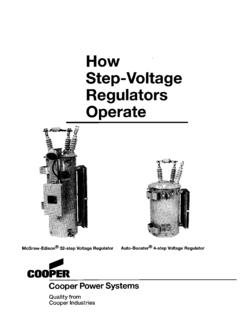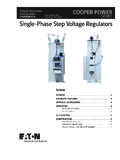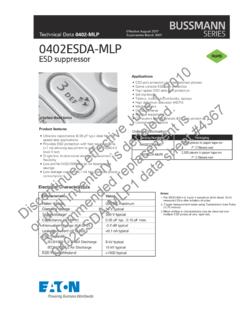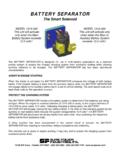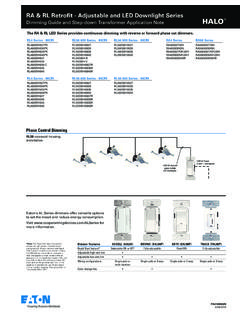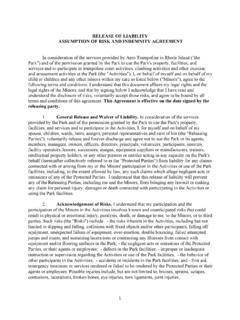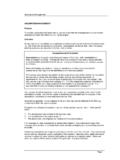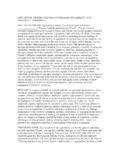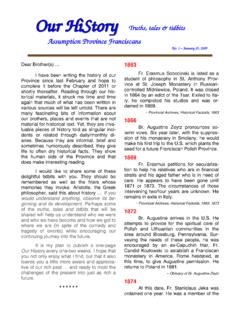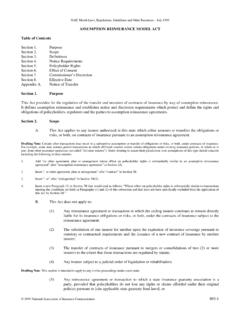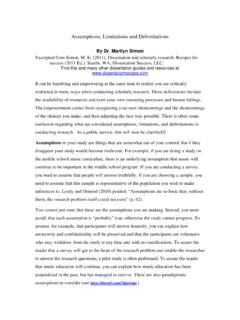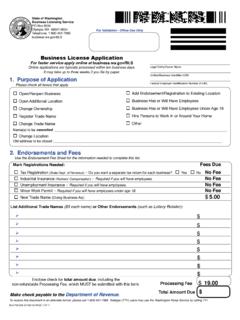Transcription of Assumption Fact - Cooper Industries
1 Vibration Isolation52B-Line series Seismic Bracing ProductsEatonThe Theory of Vibration IsolationBackgroundSoils, floors, ceilings, walls, etc. deflect as the result of applied forces. Cyclical forces generated by machines result in work done onthe floors, etc. Under steady state conditions, this work is stored as potential energy in the floor each cycle and returned as work inforcing the machine back to its equilibrium position. Disturbance is transmitted during this Isolation is needed when disturbing force magnitudes are expected to be great enough to cause damage or We know the effects of vibration isolation (efficiency)Formula for calculation shown We know the magnitude of the disturbing forces createdEquipment manufacturers rarely provide these the machinesThese forces are seldom known except in We know the magnitude of disturbing forces beyondDetailed calculations require so many simplifying assumptionsthat the resulting answers have questionable value in additionto being prohibitively expensive.
2 Reliance is placed on briefcalculations, general rules, and past of items 1. and 2. is essential to determine acceptable isolation efficiency. Unfortunately manifold complexities prevent inclusion of steps for determination of these efficiencies in this IsolationProper SizingOnce it is determined as to what type of vibration dampening device is needed, weight loading is the next crucial step. As a built in safety measure, take the actual weight of supported pipe or equipment (consider all accessories - valves, insulation, brackets, ) and multiply by Then refer to the sizing chart for the selected product to determine part number. Sizing: Divide weight of equipment by points of support to determine load requirement per : 240 Lb.
3 ( kg) piece of equipment, 4 support points, take 240 x = 300 Lbs. ( ) (safety measure), then take 300 4 = 75 Lbs. ( kg) Specify appropriate vibration device rated at75 Lbs. ( kg) for each of the support weight of equipment is unequally proportionate, select mounts to satisfy the weight frequency of isolation system fn(cycles per minute)Visualize a machine suspended barely above 4 springs (one on each corner). Now release the suspension. The machine will deflectthe springs and be pushed up and return a number of times with diminishing deflection until it comes to rest. The spring deflectionat rest is called the static deflection. The number of cycles per unit time is the natural frequency of the isolation system.
4 Unlikemulti-degree of freedom floors with limitless natural frequencies, springs essentially have only one natural force ft(pounds) ft= fd(100% - isolation efficiency)Note that fn must be compared to fdfor satisfactory isolation efficiency. Also note that the force transmitted can be greater thanthe disturbing force when fnis close to or equals fd. This condition is called resonance and is avoided in vibration frequency of floor or soilVisualize the effect of dropping a load on the floor. This floor will deflect and spring back diminishingly a number of cycles until itcomes to rest. The number of these cycles per unit time is a natural frequency of the floor. It is essentially independent of the magnitude of deflection and hence is a characteristic of a given floor if given a light tap or a hard jolt at the same location.
5 The floorhas many natural frequencies. The lowest natural frequency is called the fundamental. It is characterized by maximum deflection atmid span. The higher natural frequencies are generally less bothersome than the fundamental since they are less likely to be excited by machines in common use and are more quickly damped. The greater a floor deflects under a given load, the lower thefundamental frequency of that floor. Soft, springy floors have low fundamentals. Hard, solid floors have high frequency fd(cycles per minute)With few exceptions, the speed (RPM) of the machine will be most representative of the frequency of the are more readily transmitted when the disturbing frequency is close to a natural frequency of the floor or this reason, these characteristics are important considerations i designing a trouble-free force fd(pounds)The disturbing force causes the problem.
6 It is constantly changing from maximum positive through zero to maximum negativethrough zero to maximum positive each cycle. It results from unbalanced reciprocating and rotating masses. Its peak magnitudevaries from ounces to tons. From less than 1% to over 60% of the weight of some types of machines. Generally this force willincrease with time in a given machine as bearings wear, deposits form and moving parts get out of balance with each deflection (inches)fn= 188 Vibration isolation efficiency % = 100% x 1 - 1(fd fn)2- 1[ ]All dimensions in charts and on drawings are in inches. Dimensions shown in parentheses are in millimeters unless otherwise Isolation53B-Line series Seismic Bracing ProductsEatonVibration IsolationCritical Installations96% to 99% Vibration Isolation Efficiency recommended (only 1% to 4% of disturbing vibration transmitted).
7 Standard Installations90% to 95% Vibration Isolation Efficiency recommended (only 5% to 10% of disturbing vibration transmitted).Non-Critical Installations75% to 89% Vibration Isolation Efficiency recommended (only 11% to 24% of disturbing vibration transmitted). For 1/4" ( )deflection: Specify B-Line series RM and RQ Neoprene Mountings or B-Line series RH Neoprene 1/2" ( )deflection: Specify B-Line series RMD and RQD, (or JQTN fo OSHPD pre-approved) Neoprene Mountings or B-Line series RHD Neoprene 1"-2" ( )deflection: Specify B-Line series CHSCS, CH30 SCS, HHSCS, and HH30 SCS Housed Spring larger deflection requirements, consult Computer Isolation Efficiency1static deflection (inches)fn= 188 Transmissibility = 1(fd fn)2- 13 HX = 180 cpm = DeflectionfdDisturbing Frequency - (cycles per minute)Undamped Static Deflection - (Inches)% Isolation Efficiency 100% - Transmissibility(Cycles Per Minute)fnNatural Frequency of Isolation SystemAll dimensions in charts and on drawings are in inches.
8 Dimensions shown in parentheses are in millimeters unless otherwise Isolation54B-Line series Seismic Bracing ProductsEatonVibration IsolationNNP Type - Ribbed Neoprene Vibration PadUse: Is used under equipment to dampen noise and vibration in floor caused by medium and high speed equipment. Recommended load capacity:Up to 50 ( kgf/mm2) with a range of25-70 ( kgf/mm2) Thickness: 3/8 ( ) The NNP type has a deflection of 1/8" ( ).For greater deflection, use multiple pads in layers Non-skid: The pad has an alternating height rib patternto minimize slip Durable: Material is oil-resistant Neoprene Typical Applications: Air conditioners, cooling towers,compressors, fans, generators, pumps, piping,process equipment, transformers, (kN)in.
9 (mm)in. (mm) (kg)NNP-4200(.89)2"( )2"( ) (.02)NNP-9450( )3"( )3"( ) (.05)NNP-16800( )4"( )4"( ) (.08)NNP-361800( )6"( )6"( ) (.18)NNP-814050( )9"( )9"( ) (.39)NNP-32416200( )18"( )18"( ) ( )3/8 ( )LWCNP Type - Cork and Ribbed Neoprene Vibration PadUse: Is used under equipment to dampen noise and vibration in floor caused by medium and high speed equipment. Recommended load capacity:Up to 50 ( kgf/mm2) with a range of25-70 ( kgf/mm2) Thickness: 1 ( ) The NNP type has a deflection of 3/16" ( ).For greater deflection, use multiple pads in layers Non-skid: The pad has an alternating height rib patternto minimize slip Durable: Material is oil-resistant Neoprene Typical Applications: Air conditioners, cooling towers,compressors, fans, generators, pumps, piping,process equipment, transformers, (kN)in.
10 (mm)in. (mm) (kg)CNP-4200(.89)2"( )2"( )48 .07(.03)CNP-9450( )3"( )3"( )36 .16(.07)CNP-16800( )4"( )4"( )24 .28(.13)CNP-251250( )5"( )5"( )24 .44(.20)CNP-361800( )6"( )6"( )24 .63(.29)CNP-814050( )9"( )9"( )Bulk (.64)CNP-32416200( )18"( )18"( )6 ( )CNP-3x365400( )3"( )36"( )6 (.86)CNP-4x367200( )4"( )36"( )6 ( )1 ( )LWAll dimensions in charts and on drawings are in inches. Dimensions shown in parentheses are in millimeters unless otherwise Isolation55B-Line series Seismic Bracing ProductsEatonVibration IsolationCNNK Type - Cork, Ribbed Neoprene and Steel Vibration PadUse: Is used to dampen noise and vibration in floor caused by medium and high speed equipment.
